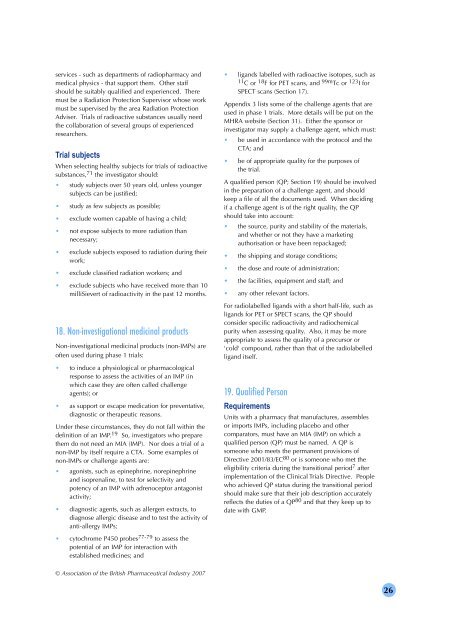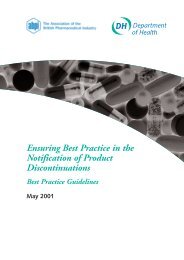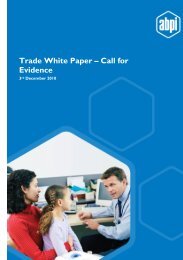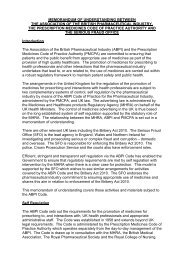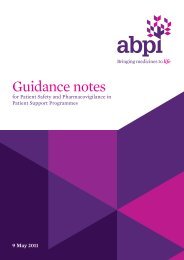ABPI Guidelines for Phase 1 Clinical Trials (PDF
ABPI Guidelines for Phase 1 Clinical Trials (PDF
ABPI Guidelines for Phase 1 Clinical Trials (PDF
You also want an ePaper? Increase the reach of your titles
YUMPU automatically turns print PDFs into web optimized ePapers that Google loves.
services - such as departments of radiopharmacy and<br />
medical physics - that support them. Other staff<br />
should be suitably qualified and experienced. There<br />
must be a Radiation Protection Supervisor whose work<br />
must be supervised by the area Radiation Protection<br />
Adviser. <strong>Trials</strong> of radioactive substances usually need<br />
the collaboration of several groups of experienced<br />
researchers.<br />
Trial subjects<br />
When selecting healthy subjects <strong>for</strong> trials of radioactive<br />
substances, 71 the investigator should:<br />
• study subjects over 50 years old, unless younger<br />
subjects can be justified;<br />
• study as few subjects as possible;<br />
• exclude women capable of having a child;<br />
• not expose subjects to more radiation than<br />
necessary;<br />
• exclude subjects exposed to radiation during their<br />
work;<br />
• exclude classified radiation workers; and<br />
• exclude subjects who have received more than 10<br />
milliSievert of radioactivity in the past 12 months.<br />
18. Non-investigational medicinal products<br />
Non-investigational medicinal products (non-IMPs) are<br />
often used during phase 1 trials:<br />
• to induce a physiological or pharmacological<br />
response to assess the activities of an IMP (in<br />
which case they are often called challenge<br />
agents); or<br />
• as support or escape medication <strong>for</strong> preventative,<br />
diagnostic or therapeutic reasons.<br />
Under these circumstances, they do not fall within the<br />
definition of an IMP. 19 So, investigators who prepare<br />
them do not need an MIA (IMP). Nor does a trial of a<br />
non-IMP by itself require a CTA. Some examples of<br />
non-IMPs or challenge agents are:<br />
• agonists, such as epinephrine, norepinephrine<br />
and isoprenaline, to test <strong>for</strong> selectivity and<br />
potency of an IMP with adrenoceptor antagonist<br />
activity;<br />
• diagnostic agents, such as allergen extracts, to<br />
diagnose allergic disease and to test the activity of<br />
anti-allergy IMPs;<br />
• cytochrome P450 probes 77-79 to assess the<br />
potential of an IMP <strong>for</strong> interaction with<br />
established medicines; and<br />
© Association of the British Pharmaceutical Industry 2007<br />
• ligands labelled with radioactive isotopes, such as<br />
11 C or 18 F <strong>for</strong> PET scans, and 99m Tc or 123 I <strong>for</strong><br />
SPECT scans (Section 17).<br />
Appendix 3 lists some of the challenge agents that are<br />
used in phase 1 trials. More details will be put on the<br />
MHRA website (Section 31). Either the sponsor or<br />
investigator may supply a challenge agent, which must:<br />
• be used in accordance with the protocol and the<br />
CTA; and<br />
• be of appropriate quality <strong>for</strong> the purposes of<br />
the trial.<br />
A qualified person (QP; Section 19) should be involved<br />
in the preparation of a challenge agent, and should<br />
keep a file of all the documents used. When deciding<br />
if a challenge agent is of the right quality, the QP<br />
should take into account:<br />
• the source, purity and stability of the materials,<br />
and whether or not they have a marketing<br />
authorisation or have been repackaged;<br />
• the shipping and storage conditions;<br />
• the dose and route of administration;<br />
• the facilities, equipment and staff; and<br />
• any other relevant factors.<br />
For radiolabelled ligands with a short half-life, such as<br />
ligands <strong>for</strong> PET or SPECT scans, the QP should<br />
consider specific radioactivity and radiochemical<br />
purity when assessing quality. Also, it may be more<br />
appropriate to assess the quality of a precursor or<br />
'cold' compound, rather than that of the radiolabelled<br />
ligand itself.<br />
19. Qualified Person<br />
Requirements<br />
Units with a pharmacy that manufactures, assembles<br />
or imports IMPs, including placebo and other<br />
comparators, must have an MIA (IMP) on which a<br />
qualified person (QP) must be named. A QP is<br />
someone who meets the permanent provisions of<br />
Directive 2001/83/EC 80 or is someone who met the<br />
eligibility criteria during the transitional period 7 after<br />
implementation of the <strong>Clinical</strong> <strong>Trials</strong> Directive. People<br />
who achieved QP status during the transitional period<br />
should make sure that their job description accurately<br />
reflects the duties of a QP 80 and that they keep up to<br />
date with GMP.<br />
26


